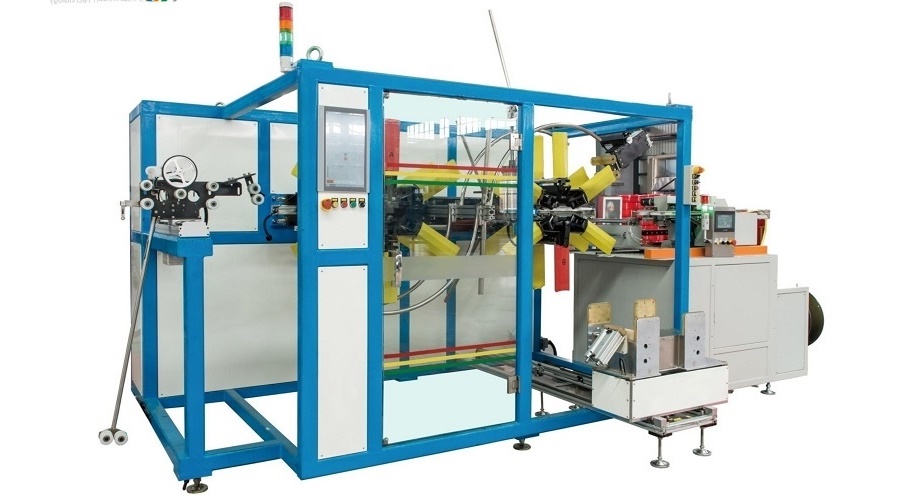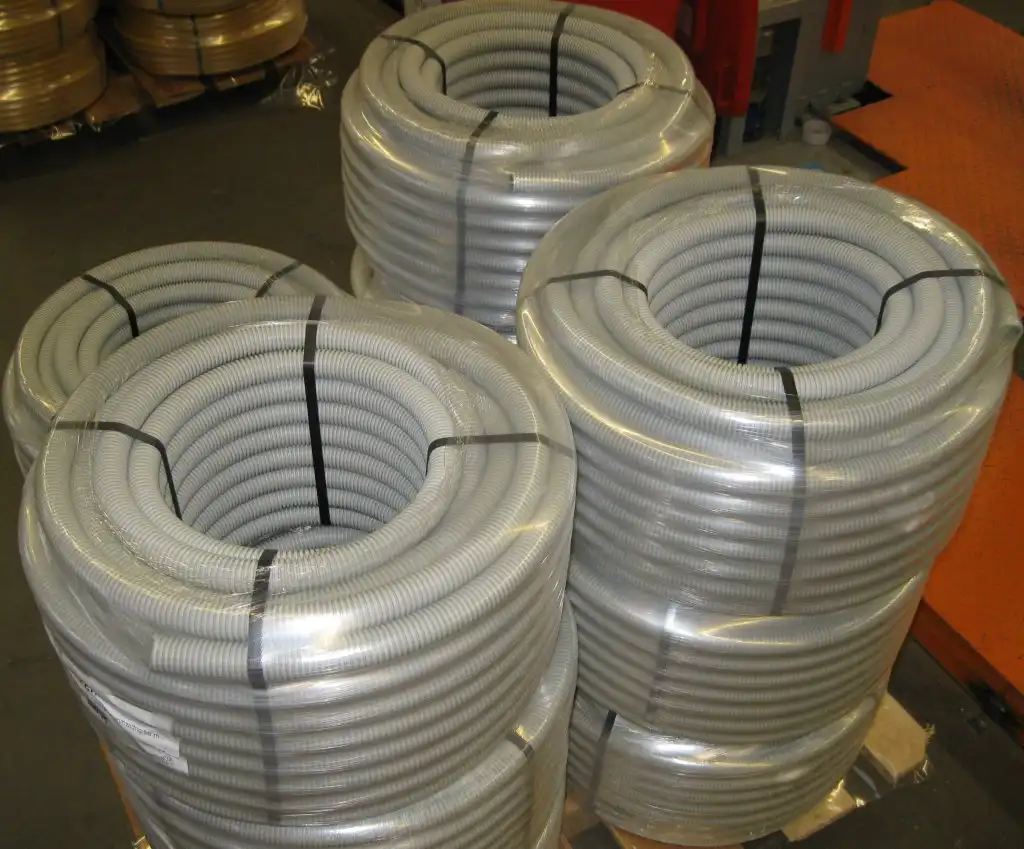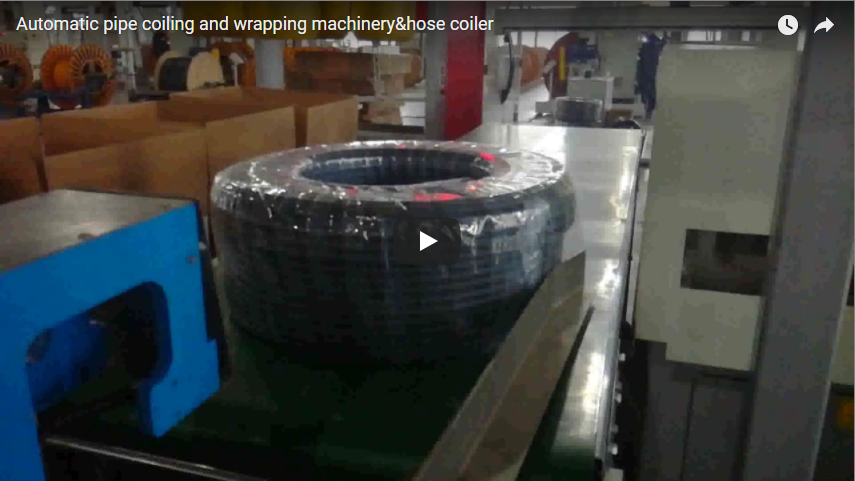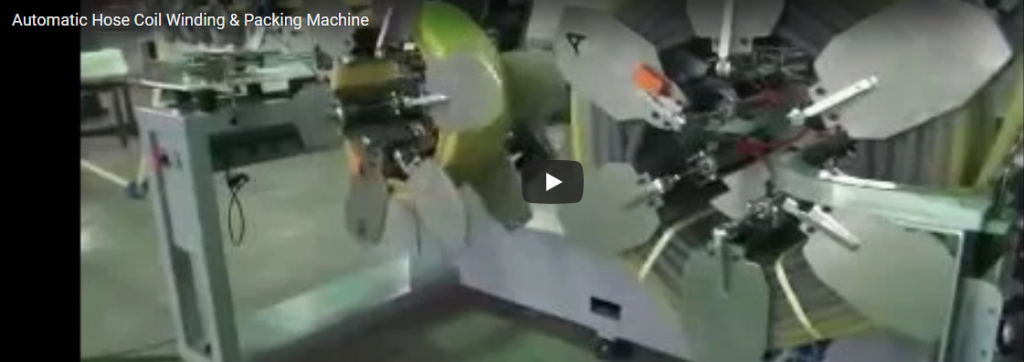Enhancing Hose & Pipe Packaging: A Technical Look at Automatic Coiling and Strapping Machines
Efficiently handling and packaging long lengths of hose or pipe is a common challenge in manufacturing. Manual coiling and securing are labor-intensive, inconsistent, and can lead to ergonomic issues. Automatic coiling and strapping machines offer a streamlined solution, improving productivity, coil quality, and package security. This article explores the operational principles, technical specifications, and practical benefits of these integrated systems.
1. Operational Workflow: From Extrusion to Packaged Coil
An automatic hose coiler with an integrated strapping function typically follows a synchronized process:
- Infeed: The machine receives the hose or pipe directly from an extrusion line or a payoff stand. Guide rollers ensure proper alignment.
- Length Measurement: A precise measuring device (often an encoder wheel) tracks the incoming length.
- Coiling: The hose/pipe is fed onto a rotating coiling head or into a coiling basket. The machine carefully guides the material to form a neat, layered coil of a predetermined length and diameter.
- Cutting: Once the target length is reached, an automated cutting mechanism (e.g., shear, blade) cleanly severs the hose or pipe.
- Coil Transfer (if applicable): The finished coil may be automatically transferred from the coiling head to a strapping station. In some designs, strapping occurs directly on the coiling head.
- Strapping: One or more strapping units apply plastic (PP or PET) straps around the coil's circumference at pre-set positions. The straps are automatically tensioned, sealed (heat or friction weld), and cut.
- Ejection/Discharge: The securely strapped coil is ejected onto a conveyor, collection table, or tilting mechanism for removal.
2. Key Technical Specifications to Consider
Selecting the right machine requires understanding its capabilities. Key parameters typically include:
- Product Range:
- Hose/Pipe Diameters: e.g., 10mm - 63mm (specify range based on model)
- Material Compatibility: PE, PEX, PVC, PA, Reinforced Hoses, etc.
- Coil Dimensions:
- Coil Inner Diameter (ID): Adjustable, e.g., 300mm - 800mm
- Coil Outer Diameter (OD): Max capacity, e.g., up to 1200mm
- Coil Width/Height: Max capacity, e.g., up to 500mm
- Performance:
- Coiling Speed: Variable, e.g., up to 100 m/min (depends on product/coil size)
- Length Accuracy: e.g., +/- 0.5%
- Cycle Time: Dependent on coil length and number of straps.
- Strapping System:
- Strap Type: PP (Polypropylene) or PET (Polyester)
- Strap Width: e.g., 9mm, 12mm, 16mm
- Number of Straps: Programmable (e.g., 2, 3, or 4 straps per coil)
- Tension Control: Adjustable
- Sealing Method: Heat Seal / Friction Weld
- Control System:
- PLC (Programmable Logic Controller) based automation
- HMI (Human Machine Interface): Touch screen panel for parameter setting, recipe storage, diagnostics.
- Compliance: CE marking, adherence to relevant safety standards.
- Utilities:
- Power Supply: Voltage/Frequency/Phase (e.g., 400V/50Hz/3Ph)
- Compressed Air: Pressure/Consumption (e.g., 6 bar)

3. Core Features and Operational Advantages
Modern automatic coiling and strapping machines incorporate features designed for efficiency and quality:
- Precision Coiling: Servo-driven traverse guides ensure neat, layer-wound coils, preventing tangles and improving appearance. Adjustable coiling speeds accommodate different material characteristics.
- Accurate Cutting: Automated cutting provides consistent lengths, reducing material waste compared to manual methods.
- Integrated Strapping: Eliminates manual strapping, ensuring consistent tension and placement for coil stability during handling and transport. Multiple strap application enhances security for larger or heavier coils.
- User-Friendly Controls: Touch screen HMIs allow operators to easily set coil parameters (length, ID, OD limits), strapping positions, and tension. Storing recipes for different products speeds up changeovers. Diagnostics help troubleshoot issues quickly.
- Versatility: Many machines can handle a range of hose/pipe diameters and materials with minimal adjustment, often managed through saved recipes on the HMI.
- Synchronization: Ability to synchronize speed with the upstream extrusion line ensures smooth, continuous operation without excessive tension or slack.
4. Practical Considerations for Implementation
From an operational standpoint, consider these factors:
- Line Integration: Ensure seamless communication and speed synchronization if linking directly to an extruder. Buffer systems (like a dancer arm or accumulator) might be needed.
- Material Handling: Plan for efficient loading of raw material (if not direct from extrusion) and removal of finished, strapped coils.
- Changeover Time: Evaluate how quickly and easily the machine can be adjusted for different product dimensions or coiling recipes. Features like quick-release coiling heads can minimize downtime.
- Maintenance: Understand routine maintenance requirements (lubrication, blade sharpening/replacement, strap feeder cleaning) and accessibility for service.
- Operator Training: While HMIs simplify operation, proper training is essential for setup, troubleshooting, and safety procedures.
5. Safety and Compliance
These machines operate automatically and involve moving parts, cutting actions, and strap tensioning. Key safety features include:
- Physical Guarding: Interlocked guards prevent access to moving parts during operation.
- Emergency Stops: Easily accessible E-stop buttons strategically placed around the machine.
- Safety Relays/PLCs: Monitoring of safety circuits.
- CE Marking: Indicates compliance with European health, safety, and environmental protection standards.

Conclusion
Automatic hose coiling and strapping machines represent a significant step forward in packaging efficiency for hose and pipe manufacturers. By combining precise coiling, accurate cutting, and secure strapping into a single automated process, these systems offer substantial benefits in terms of labor savings, consistent product quality, improved package integrity, and enhanced operational safety. Evaluating the technical specifications and operational features against specific production needs is key to selecting a system that delivers maximum return on investment.






